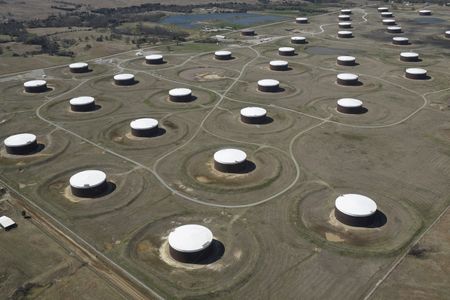
By Stephanie Kelly
NEW YORK (Reuters) – Oil prices surged to fresh seven-year highs on Friday, headed for a seventh straight weekly increase, built on ongoing worries about supply disruptions fueled by frigid U.S. weather and ongoing political turmoil among major world producers.
Brent crude rose $2.25, or 2.5%, to $93.36 a barrel by 10:32 a.m. EST (1532 GMT), having earlier touched its highest since October 2014 at $93.70.
U.S. West Texas Intermediate crude rose $2.59, or 2.9%, to $92.86 a barrel. It hit a session high of $93.17 a barrel, highest since September 2014.
Both benchmarks were on course for a seventh straight weekly gain. Brent was set to end the week 3.5% higher, while WTI was on track for a 6.7% rise.
The market’s surge has accelerated in the last two days, as buyers pile into crude contracts due to expectations that world suppliers will continue to struggle to meet demand. U.S. jobs figures were surprisingly strong in January, despite the presence of the Omicron variant of the coronavirus.
So far this year, U.S. crude has rallied nearly 24% while Brent has gained 20%. Crude prices are likely to surpass $100 per barrel due to strong global demand, market strategists said this week.
Some, however, see risks to the rally. Citi Research said it expects the oil market to flip into surplus as soon as the next quarter, putting the brakes on the rally.
“A spike towards $100 crude should not be ruled out in the short run, but downside risks are plentiful, including Omicron setbacks on demand, economic growth concerns and financial market corrections as the central banks fight inflation,” said Bjørnar Tonhaugen, Rystad Energy’s head of oil markets.
Winter storms bringing icy conditions in the United States – particularly in Texas – were also fueling the gains, due to expectations that extreme cold could cause production to shut temporarily, similar to what happened in the state in February 2021.
Tight oil supplies pushed the six-month market structure for WTI into steep backwardation of $9.06 a barrel on Friday, widest since September 2013.
Backwardation exists when contracts for near-term delivery are priced higher than those for later months – and is reflective of near-term demand that encourages traders to release oil from storage to sell it promptly.
Oil markets have also gained support from tensions surrounding the Ukraine crisis, which have heightened concerns over oil supplies that are already tight. Russia has amassed thousands of troops on Ukraine’s border, and is accusing the United States and its allies of fanning tensions.
The Organization of the Petroleum Exporting Countries (OPEC) and allies led by Russia, together known as OPEC+, agreed this week to stick to moderate output increases of 400,000 barrels per day (bpd), with the group already struggling to meet existing targets and despite pressure from top consumers to raise production more quickly.
Iraq, OPEC’s second-largest oil producer, pumped well below its OPEC+ quota in January, while OPEC+ member Kazakhstan wants to keep more of its oil output at home to tackle rising fuel prices.
(Reporting by Stephanie Kelly in New York; additional reporting by Rowena Edwards in London and Roslan Khasawneh in Singapore; Editing by David Goodman and Marguerita Choy)

